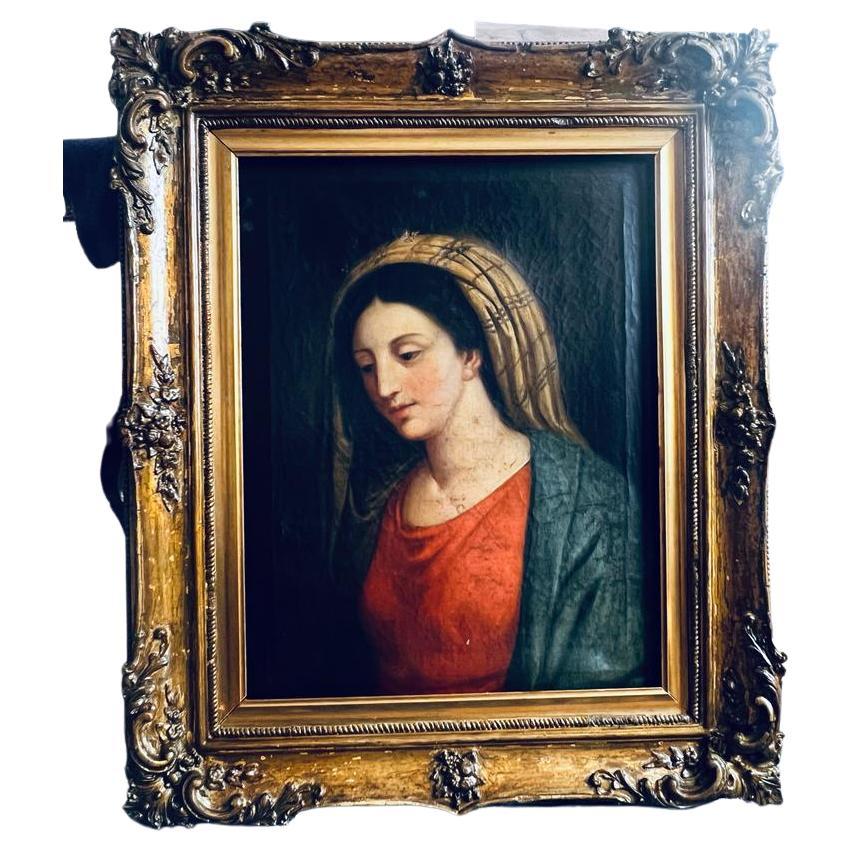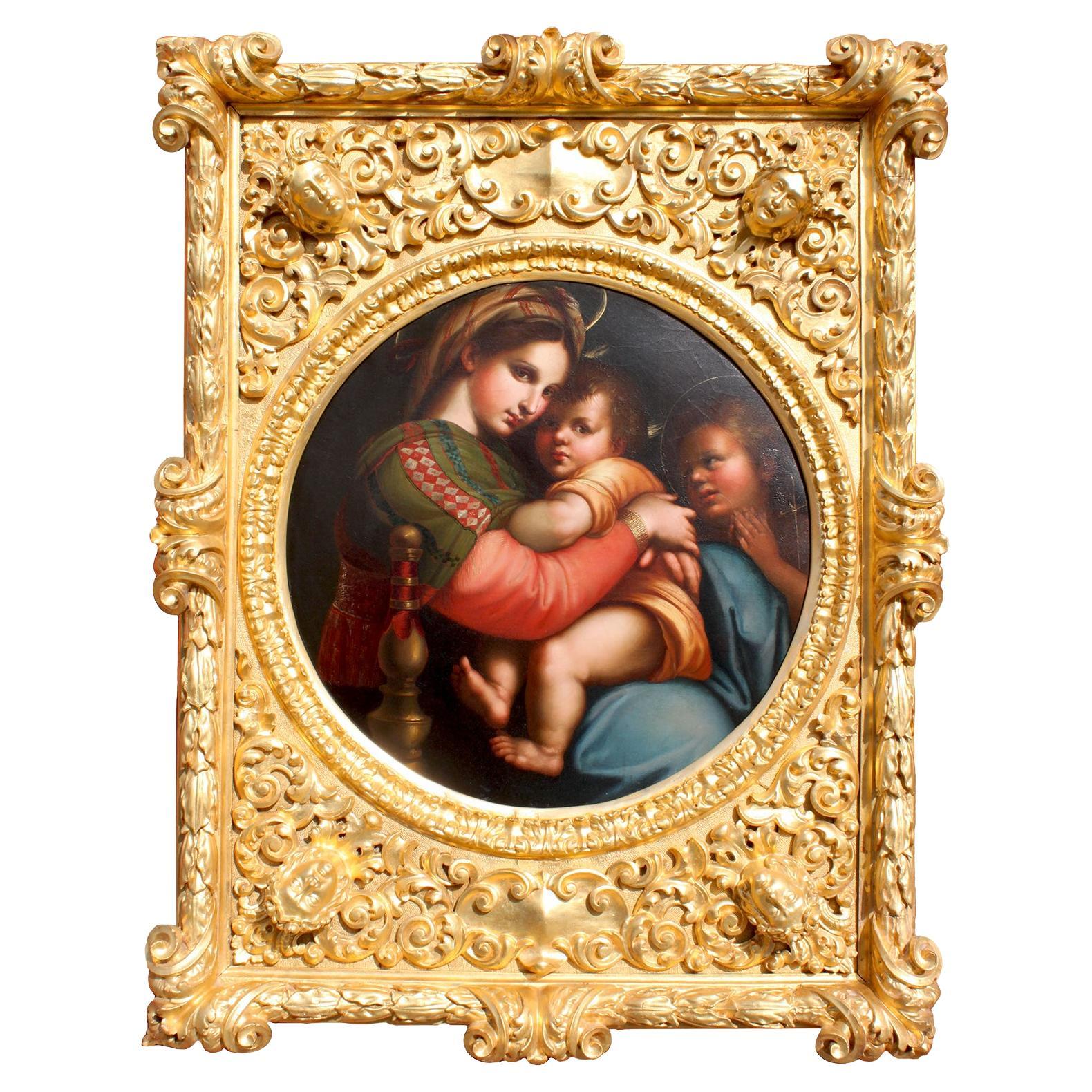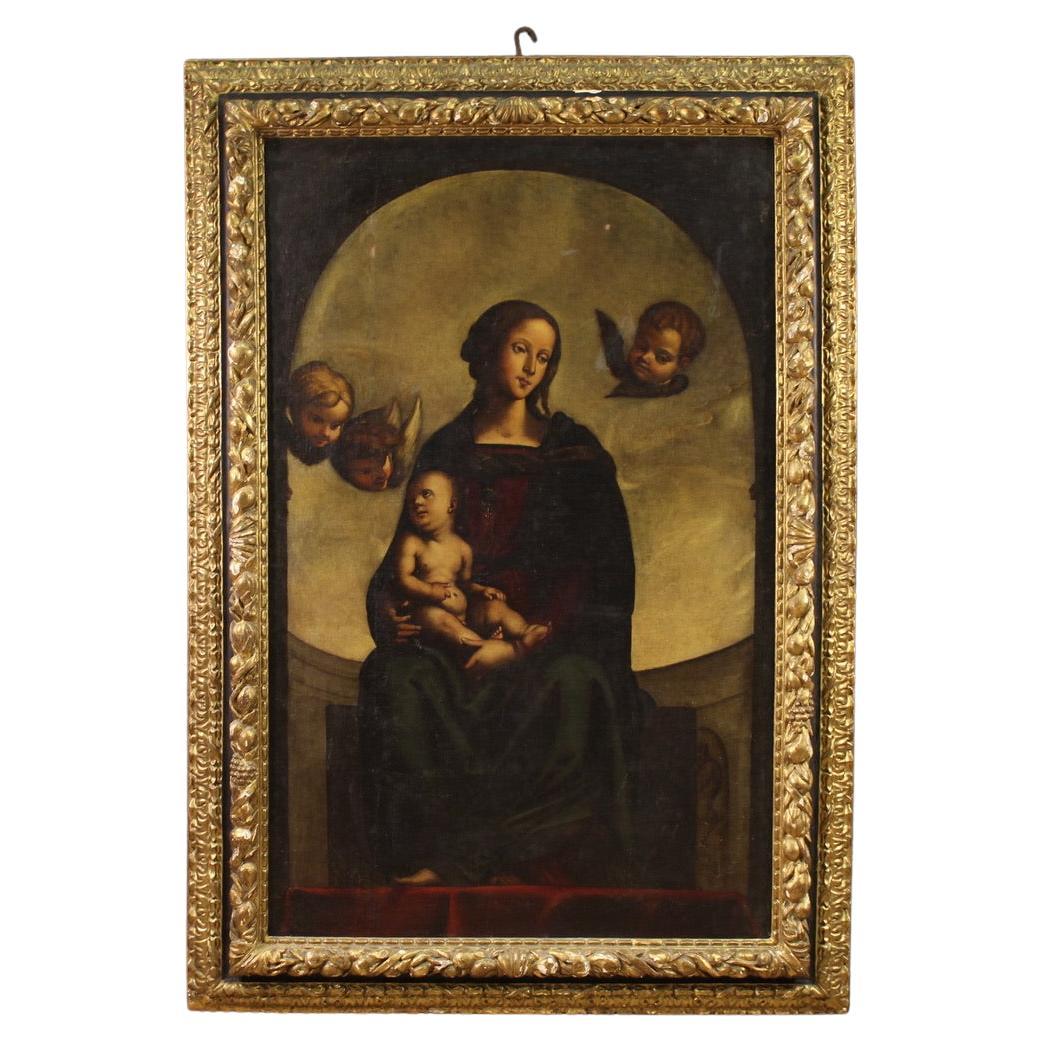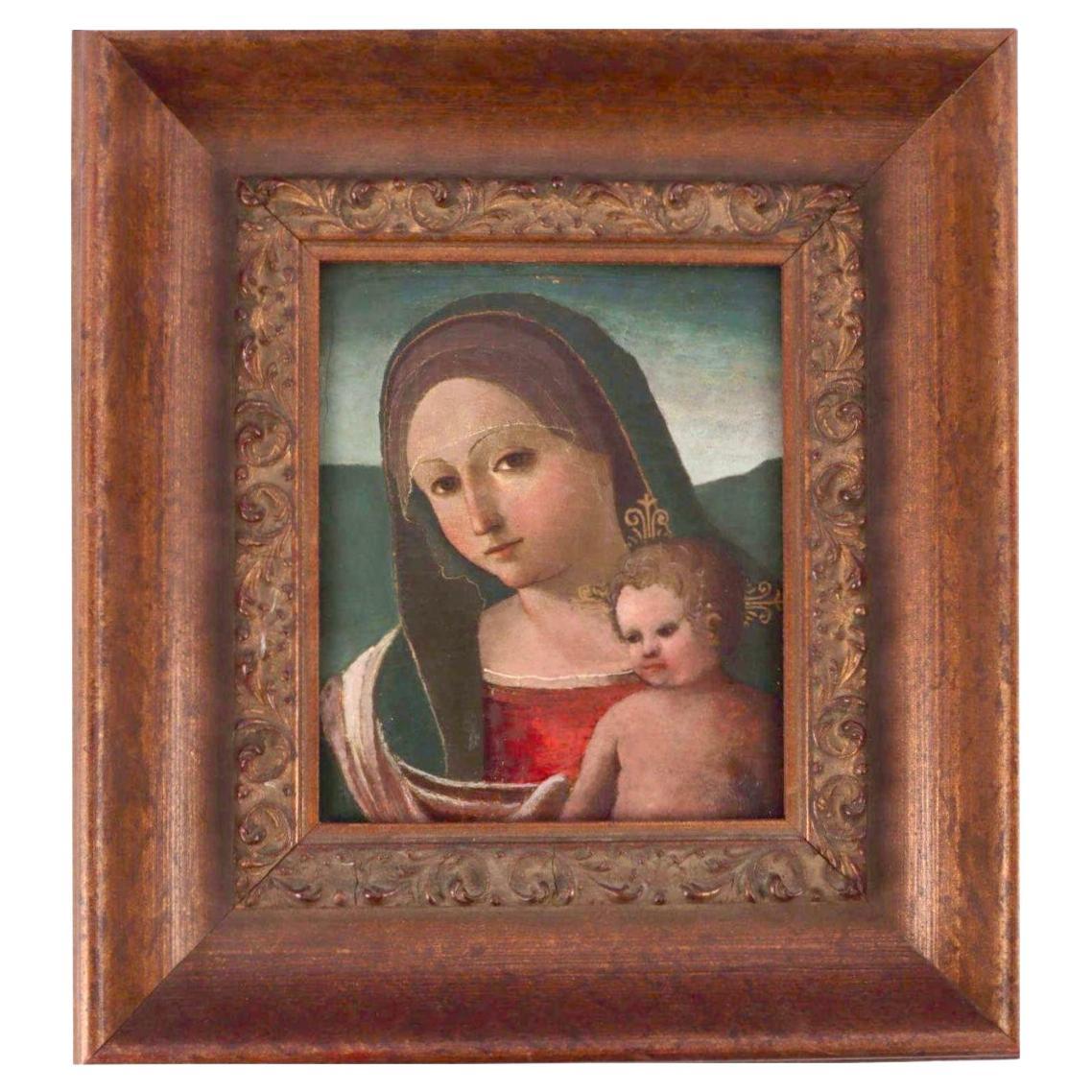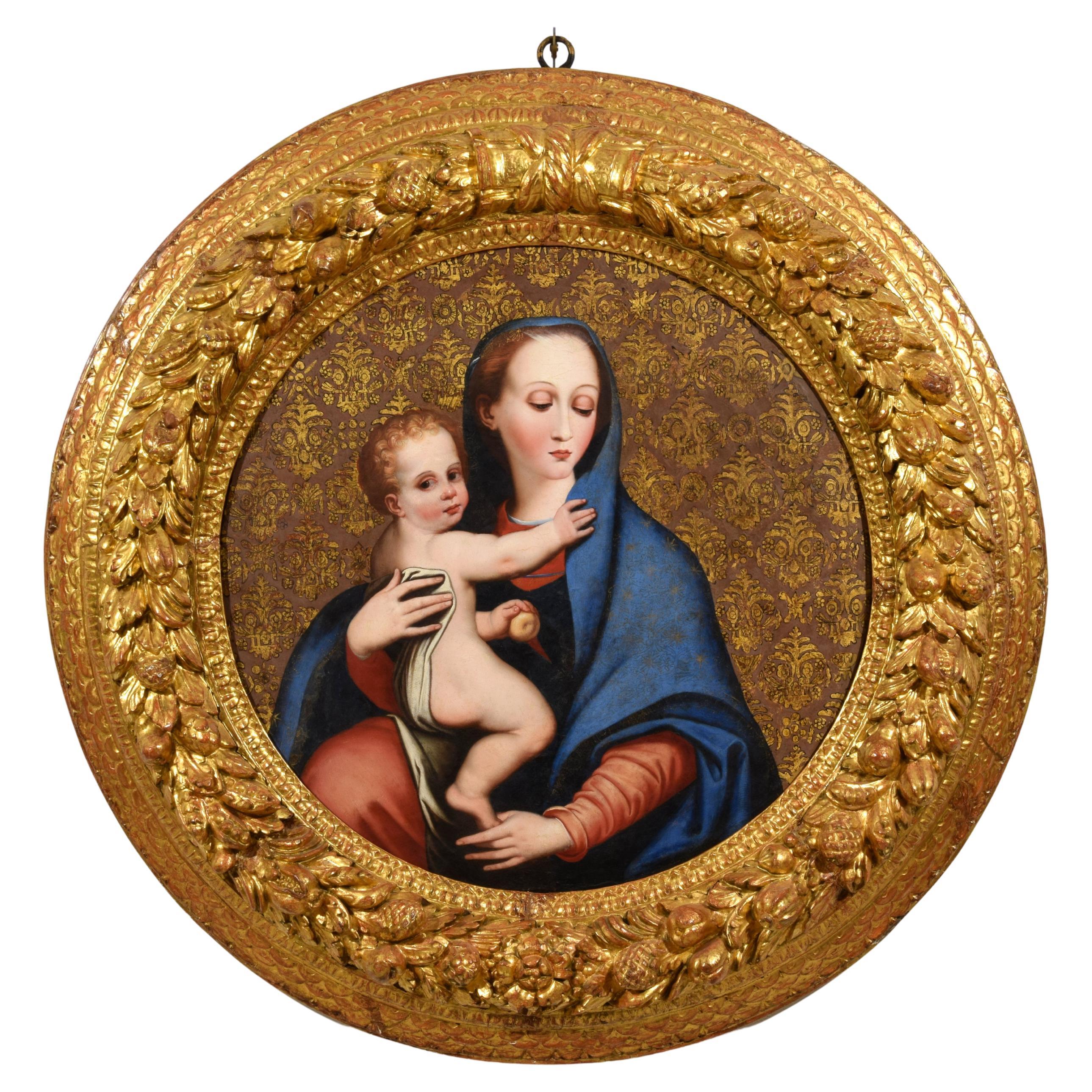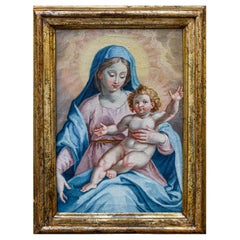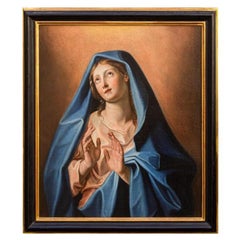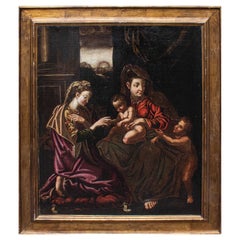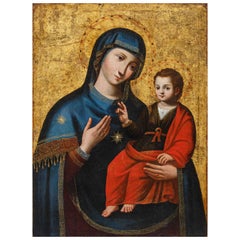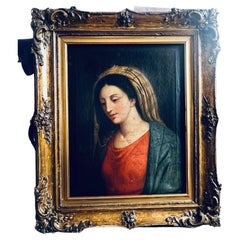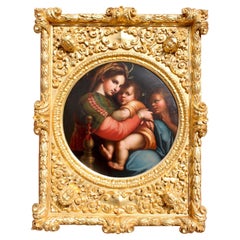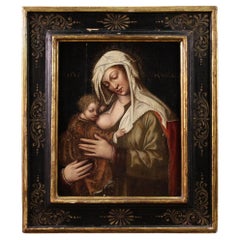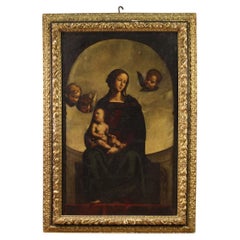Items Similar to 16th Century Madonna of the Carnations Painting Oil on Canvas from Raffaello
Want more images or videos?
Request additional images or videos from the seller
1 of 13
16th Century Madonna of the Carnations Painting Oil on Canvas from Raffaello
$5,592.92
£4,218.09
€4,800
CA$7,732.70
A$8,661.93
CHF 4,549.56
MX$105,326.25
NOK 57,612.25
SEK 54,689.52
DKK 36,540.74
About the Item
16th century, by Raffaello Sanzio (Urbino, 1483 - Rome, 1520)
Madonna of the Carnations
Measures: Oil on canvas 38 x 30 - with frame 59 x 52.5 cm
The Madonna dei Garofani made by Raffaello Sanzio (Urbino, 1483 - Rome, 1520) has become a very successful iconographic model and has many replicas, such as the one examined here.
The Raphaelesque original, now exhibited at the National Gallery in London, was made between 1503 and 1507, when the painter was about 23 years old. The London specimen has been identified as the original and there are about fifty copies of it as evidence of the great success achieved among the clients (Madonna di Siracursa, Madonna Chatron; there is also a copy made by Federico Barocci - Galleria Borghese). Influence on Raphael by Leonardo da Vinci and, in particular, of the Benois Madonna (Hermitage Museum, St. Petersburg). The sacred image also owes its diffusion to the numerous engravings that circulated from shop to shop.
Raphael's painting is a religious work intended for private devotion. Raphael manages to transform the classic subject of the Madonna and Child into a representation with a familiar tone. The young mother and her son are no longer depicted in rigid and formal poses, as in the paintings of previous artists, but have abandoned all formality, letting themselves go into a tenderly intimate attitude and letting all the emotions of their relationship shine through. The Madonna exchanges with Jesus some small red carnations which represent by their color the blood that Jesus will shed in the future on the cross (according to tradition, the carnation is considered a symbol of divine love and it is believed that it blossomed from the earth where the tears of the Virgin during the Passion of Christ.). Furthermore, they also refer to the marriage between Christ and the universal Church represented by Mary. Finally, the four-poster bed symbolizes the virginity of the Madonna.
This replica, to be dated to the 16th century, was created by an artist familiar with the Raphaelesque original, an image that spread mainly through engravings. The entire composition is overturned with respect to the autographed copy, but here too the Virgin and Child Jesus are in a room immersed in the shade. Maria wears a pink dress (in the original gray) decorated on the sleeves with puffed motifs. In addition, she wears on her legs the blue cloak on which the white pillow rests. The Child, on the other hand, is naked (even if a soft cloth cores his nakedness) and sits on the legs of the Mother and observes the flowers that he holds in her hands. Inside there is a canopy bed and from the window you can glimpse a countryside landscape with some ruins.
- Similar to:Raphael (Raffaello Sanzio da Urbino) (Painter)
- Dimensions:Height: 23.23 in (59 cm)Width: 20.87 in (53 cm)Depth: 1.58 in (4 cm)
- Materials and Techniques:
- Place of Origin:
- Period:
- Date of Manufacture:16th Century
- Condition:Refinished. Wear consistent with age and use. The painting has been cleaned.
- Seller Location:Milan, IT
- Reference Number:1stDibs: LU5918229644822
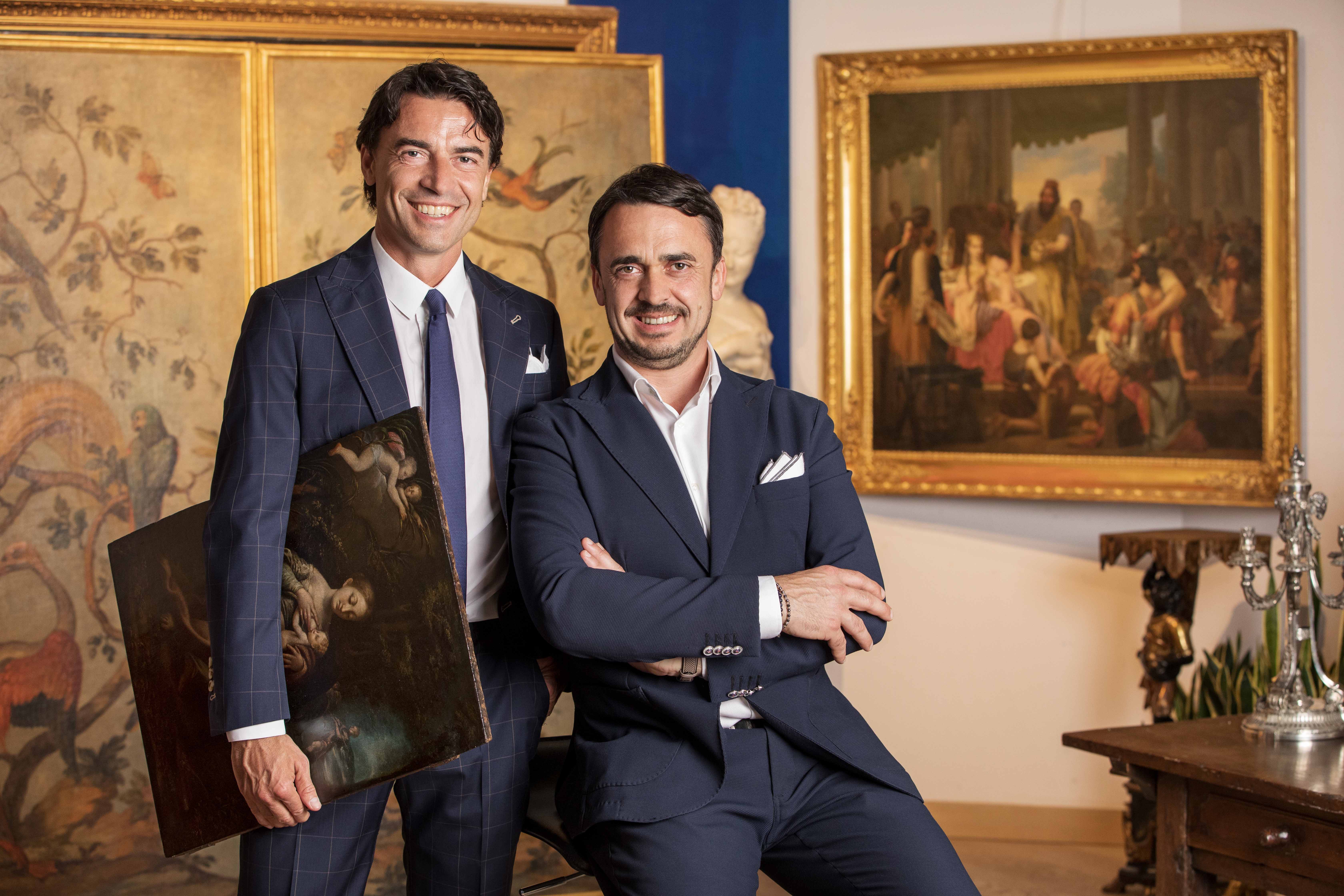
About the Seller
5.0
Vetted Professional Seller
Every seller passes strict standards for authenticity and reliability
Established in 2000
1stDibs seller since 2021
30 sales on 1stDibs
- ShippingRetrieving quote...Shipping from: Milan, Italy
- Return Policy
Authenticity Guarantee
In the unlikely event there’s an issue with an item’s authenticity, contact us within 1 year for a full refund. DetailsMoney-Back Guarantee
If your item is not as described, is damaged in transit, or does not arrive, contact us within 7 days for a full refund. Details24-Hour Cancellation
You have a 24-hour grace period in which to reconsider your purchase, with no questions asked.Vetted Professional Sellers
Our world-class sellers must adhere to strict standards for service and quality, maintaining the integrity of our listings.Price-Match Guarantee
If you find that a seller listed the same item for a lower price elsewhere, we’ll match it.Trusted Global Delivery
Our best-in-class carrier network provides specialized shipping options worldwide, including custom delivery.More From This Seller
View All17th Century Madonna with Child Painting Oil on Canvas Tuscan School
Located in Milan, IT
17th century, Tuscan school
Madonna and Child
Oil on canvas, 31 x 21 cm
With frame, cm 37,5 x 27,5
The pearly incarnations and the thoughtful play of looks between the Virgin, turned to the Son, and Questi, warmly open to the viewer, pour out the present painting with compositional perfection. Virginal fabrics become mottled at the folds, wrapping the Madonna in a thin vitreous mantle. The pastel colors, shining on the pink robe just tightened at the waist by a gold cord, enliven the faces of the divine couple in correspondence of the cheeks, lit by an orange warmth. Even the left hand of the Virgin, composed in perfect classical pose (Botticelli, Madonna with Child, 1467, Musée du Petit Palais, Avignon), is sprinkled with warmth thanks to the immediate touch with Christ. From the nimbus of the Mother a delicate luminous disk is effused, which takes back, in the most distant rays, the colour of the hair of the Son, from the tones of the sun. The Child Jesus is represented intent in a tender gesture of invitation with the right hand, while with the other he offers a universal blessing: with his hand he retracts the index and annular palms, extending the remaining three fingers, symbol of Father, Son and Holy Spirit.
The painting welcomes and re-elaborates that typically Tuscan formalism that boasted in the rest of Italy the constant appreciation by the most up-to-date artists and collectors. Arrangement, composition and mixing of colors place the canvas in the middle between the changing mannerist and the sculptural figures of Michelangelo, essential yardstick of comparison in terms of anatomical and expressionistic rendering. In the present, silvery and pinkish powders act as three-dimensional inducers to the Child’s mentioned musculature and to the vivid folds of the clothes, expertly deposited on the lunar whiteness of the skins. While these colours recall the equally brilliantly transparent colours of Pier Francesco Foschi...
Category
Antique 17th Century Italian Paintings
Materials
Canvas
Early 17th Century Roman School Praying Madonna Painting Oil on Canvas
Located in Milan, IT
Roman school, late 16th-early 17th century Praying Madonna
Oil on canvas, 81 x 69 cm
Frame 83 x 95.5 cm
A divine whiteness reverberates with vibrant luster on the maphorion of the present Virgin. The palpable iridescence that structures the thin rosaceous garment, woven with the same fresh light, produces a slight rustle when she takes her hands off. The Madonna in fact takes a prayerful pose, opening her palms to underline her fervent ecstatic intention; the white neck is rendered with perishable fullness of pigments, like the hands, perfectly alive, and the very shiny eyes. With fine shrewdness the artist of the present styles the Virgin's hair with thin white ribbons, exacerbating the purity. An evocative light falls gently on the bust, a materialized sign of divine glory.
The present can be traced back to the late Mannerist climate that prevailed in the capital after the emanation of the Tridentine council (1545-1563). The late Mannerist licenses that can still be seen there, such as the intense lyricism in the stylistic code adopted by the artist, are innervated in the new basic catechetical intent, which at the end of the century produced a certain figurative rigorism. The present, however, still responds to that extraordinary Roman dynamism that raised the capital to a bulwark for the entire mannerist lesson, matched only by a second artistic center, the Florentine one. The engaging carriage of the Virgin reflects the contemporary examples of Giuseppe Valeriano (1542-1596), a Jesuit painter, returning in the Marriage of the Virgin of the Roman Church of Jesus, as well as in the Madonna of Sorrows in the Recanati Altarpiece, equal ardor. But it is in the Assumption of the Virgin painted in four hands with Scipione Pulzone...
Category
Antique Early 17th Century Italian Paintings
Materials
Canvas
17th Century Mystical Marriage of Saint Catherine Painting Oil on Canvas
Located in Milan, IT
17th century
Mystical marriage of Saint Catherine
Measures: Oil on canvas, 98 x 81 cm - with frame 119 x 102 cm
The scene represents the mystical marriage between Catherine of A...
Category
Antique 17th Century Italian Paintings
Materials
Canvas
16th century Madonna and Child Oil on canvas with gold background
Located in Milan, IT
XVII Century
Madonna and Child
Oil on canvas, 116 x 83 cm
The canvas under consideration depicts the Icon of the Most Holy Virgin Consoled, or more correctly Consoler of the Affl...
Category
Antique 17th Century Decorative Art
Materials
Canvas
Roman school, 17th century, Madonna and Child
Located in Milan, IT
Roman School, 17th century
Madonna and Child
Oil on copper, 15 x 11 cm
Framed, 26 x 22 cm
The small copper on display here depicts the Madonna and Child against a dark background...
Category
Antique 17th Century Italian Other Paintings
Materials
Copper
1848 Madonna Adoring The Sleeping Child Painting Oil on Canvas by Adele Pinot
By Guido Reni
Located in Milan, IT
Adele Pinot (1848), by Guido Reni (Bologna, 1575 - 1642)
Madonna Adoring the Sleeping Child
Oil on canvas, 97 x 107 cm
Signed lower right "Adele Pinot 1848"
The canvas examined depicts the Madonna and Child, caught in a moment of great tenderness and intimacy. Wrapped in a brilliant luminosity, the little Jesus is depicted in the foreground comfortably lying on some soft drapes. The face appears peacefully asleep and is framed by blond curls; the complexion is white and the legs, just curled up and slightly bent at the knee, help to accentuate the naturalness and sweetness of the composition. Full of tenderness and maternal love, the figure of the Madonna appears, with delicate features and a head covered by a veil, which, placed at three quarters, is totally attracted to the contemplation of her little son. The high quality that can be found in the execution of the figures is also emphasized in the rendering of the soft drapery and in the careful attention to detail.
The work, created in 1848 by the French artist Adele Pinot, re-elaborates the famous Madonna in adoration of the Child by Guido Reni (Bologna, 1575 - 1642) now preserved in the Doria Pamphilj...
Category
Antique 19th Century Italian Baroque Revival Paintings
Materials
Canvas
You May Also Like
Antique 17th Century Painting Madonna /Virgin Mary Italy Oil on Canvas
Located in Doha, QA
Magnificent Italian 17th century Portrait of Virgin Mary measures 52 x 68 cm without the frame.
The colors are stunning and the paintin...
Category
Antique 17th Century Italian Baroque Paintings
Materials
Canvas
After Raffaello Sanzio 1483-1520 Raphael La Madonna della Seggiola Oil on Canvas
By (after) Raphael (Raffaello Sanzio da Urbino)
Located in Los Angeles, CA
A Fine Italian 19th Century Oil Painting on Canvas "La Madonna della Seggiola" after Raphael (Raffaello Sanzio da Urbino 1483-1520). The circular painted canvas depicting a seated Madonna holding an infant Jesus Christ next to a child Saint John the Baptist, all within a massive carved gilt wood and gesso frame, which is identical to the frame on Raphael's original artwork. This painting is a 19th Century copy of Raphael's Madonna della Seggiola painted in 1514 and currently exhibited and part of the permanent collection at the Palazzo Pitti, Galleria Palatina, Florence, Italy. The bodies of the Virgin, Christ, and the boy Baptist fill the whole picture. The tender, natural looking embrace of the Mother and Child, and the harmonious grouping of the figures in the round, have made this one of Raphael's most popular Madonnas. The isolated chair leg is reminiscent of papal furniture, which has led to the assumption that Leo X himself commissioned the painting. A retailer's label reads " Fred K/ Keer's Sons - Framers and Fine Art Dealers - 917 Broad St. Newark, N.J." - Another label from the gilder reads "Carlo Bartolini - Doratore e Verniciatori - Via Maggio 1924 - Firenze". Circa: 1890-1900.
Subject: Religious painting
Canvas diameter: 28 inches (71.1 cm)
Frame height: 54 inches (137.2 cm)
Frame width: 42 1/2 inches (108 cm)
Frame depth: 5 1/2 inches (14 cm)
Raffaello Sanzio da Urbino (Italian, March 28 or April 6, 1483 - April 6, 1520), known as Raphael, was an Italian painter and architect of the High Renaissance. His work is admired for its clarity of form, ease of composition, and visual achievement of the Neoplatonic ideal of human grandeur. Together with Michelangelo and Leonardo da Vinci, he forms the traditional trinity of great masters of that period.
Raphael was enormously productive, running an unusually large workshop and, despite his death at 37, leaving a large body of work. Many of his works are found in the Vatican Palace, where the frescoed Raphael Rooms were the central, and the largest, work of his career. The best known work is The School of Athens in the Vatican Stanza della Segnatura. After his early years in Rome much of his work was executed by his workshop from his drawings, with considerable loss of quality. He was extremely influential in his lifetime, though outside Rome his work was mostly known from his collaborative printmaking.
After his death, the influence of his great rival Michelangelo was more widespread until the 18th and 19th centuries, when Raphael's more serene and harmonious qualities were again regarded as the highest models. His career falls naturally into three phases and three styles, first described by Giorgio Vasari: his early years in Umbria, then a period of about four years (1504–1508) absorbing the artistic traditions of Florence, followed by his last hectic and triumphant twelve years in Rome, working for two Popes and their close associates.
Raphael was born in the small but artistically significant central Italian city of Urbino in the Marche region, where his father Giovanni Santi was court painter to the Duke. The reputation of the court had been established by Federico III da Montefeltro, a highly successful condottiere who had been created Duke of Urbino by the Pope - Urbino formed part of the Papal States - and who died the year before Raphael was born. The emphasis of Federico's court was rather more literary than artistic, but Giovanni Santi was a poet of sorts as well as a painter, and had written a rhymed chronicle of the life of Federico, and both wrote the texts and produced the decor for masque-like court entertainments. His poem to Federico shows him as keen to show awareness of the most advanced North Italian painters, and Early Netherlandish artists as well. In the very small court of Urbino he was probably more integrated into the central circle of the ruling family than most court painters.
Federico was succeeded by his son Guidobaldo da Montefeltro, who married Elisabetta Gonzaga, daughter of the ruler of Mantua, the most brilliant of the smaller Italian courts for both music and the visual arts. Under them, the court continued as a centre for literary culture. Growing up in the circle of this small court gave Raphael the excellent manners and social skills stressed by Vasari. Court life in Urbino at just after this period was to become set as the model of the virtues of the Italian humanist court through Baldassare Castiglione's depiction of it in his classic work The Book of the Courtier, published in 1528. Castiglione moved to Urbino in 1504, when Raphael was no longer based there but frequently visited, and they became good friends. He became close to other regular visitors to the court: Pietro Bibbiena and Pietro Bembo, both later cardinals, were already becoming well known as writers, and would be in Rome during Raphael's period there. Raphael mixed easily in the highest circles throughout his life, one of the factors that tended to give a misleading impression of effortlessness to his career. He did not receive a full humanistic education however; it is unclear how easily he read Latin.
Early Life and Works
His mother Màgia died in 1491 when Raphael was eight, followed on August 1, 1494 by his father, who had already remarried. Raphael was thus orphaned at eleven; his formal guardian became his only paternal uncle Bartolomeo, a priest, who subsequently engaged in litigation with his stepmother. He probably continued to live with his stepmother when not staying as an apprentice with a master. He had already shown talent, according to Vasari, who says that Raphael had been "a great help to his father". A self-portrait drawing from his teenage years shows his precocity. His father's workshop continued and, probably together with his stepmother, Raphael evidently played a part in managing it from a very early age. In Urbino, he came into contact with the works of Paolo Uccello, previously the court painter (d. 1475), and Luca Signorelli, who until 1498 was based in nearby Città di Castello.
According to Vasari, his father placed him in the workshop of the Umbrian master Pietro Perugino as an apprentice "despite the tears of his mother". The evidence of an apprenticeship comes only from Vasari and another source, and has been disputed—eight was very early for an apprenticeship to begin. An alternative theory is that he received at least some training from Timoteo Viti, who acted as court painter in Urbino from 1495.Most modern historians agree that Raphael at least worked as an assistant to Perugino from around 1500; the influence of Perugino on Raphael's early work is very clear: "probably no other pupil of genius has ever absorbed so much of his master's teaching as Raphael did", according to Wölfflin. Vasari wrote that it was impossible to distinguish between their hands at this period, but many modern art historians claim to do better and detect his hand in specific areas of works by Perugino or his workshop. Apart from stylistic closeness, their techniques are very similar as well, for example having paint applied thickly, using an oil varnish medium, in shadows and darker garments, but very thinly on flesh areas. An excess of resin in the varnish often causes cracking of areas of paint in the works of both masters. The Perugino workshop was active in both Perugia and Florence, perhaps maintaining two permanent branches. Raphael is described as a "master", that is to say fully trained, in December 1500.
His first documented work was the Baronci altarpiece for the church of Saint Nicholas of Tolentino in Città di Castello, a town halfway between Perugia and Urbino. Evangelista da Pian di Meleto, who had worked for his father, was also named in the commission. It was commissioned in 1500 and finished in 1501; now only some cut sections and a preparatory drawing remain. In the following years he painted works for other churches there, including the Mond Crucifixion (about 1503) and the Brera Wedding of the Virgin (1504), and for Perugia, such as the Oddi Altarpiece. He very probably also visited Florence in this period. These are large works, some in fresco, where Raphael confidently marshals his compositions in the somewhat static style of Perugino. He also painted many small and exquisite cabinet paintings in these years, probably mostly for the connoisseurs in the Urbino court, like the Three Graces and St. Michael, and he began to paint Madonnas and portraits. In 1502 he went to Siena at the invitation of another pupil of Perugino, Pinturicchio, "being a friend of Raphael and knowing him to be a draughtsman of the highest quality" to help with the cartoons, and very likely the designs, for a fresco series in the Piccolomini Library in Siena Cathedral. He was evidently already much in demand even at this early stage in his career.
Influence of Florence
Raphael led a "nomadic" life, working in various centres in Northern Italy, but spent a good deal of time in Florence, perhaps from about 1504. Although there is traditional reference to a "Florentine period...
Category
Antique Early 1900s Italian Baroque Paintings
Materials
Canvas, Giltwood
$21,950 Sale Price
33% Off
16th Century Oil on Canvas Italian Religious Painting Madonna with Child, 1520
Located in Vicoforte, Piedmont
A rare 16th-century Italian painting. An oil on panel painting depicting a refined Madonna with Child, this artwork is of extraordinary pictorial quality. The most popular iconograph...
Category
Antique 16th Century Italian Paintings
Materials
Canvas
17th Century Oil on Canvas Altarpiece Painting Madonna with Child and Cherubs
Located in Vicoforte, Piedmont
A magnificent altarpiece from the second half of the 17th century. Painting oil on canvas depicts a splendid Madonna with Child among cherubs, a widespread iconographic theme in Ital...
Category
Antique 1670s Italian Paintings
Materials
Canvas
Italian Baroque Madonna And Child Oil On Board Painting
Located in Bradenton, FL
Very early Italian School Madonna and Child, Italian Baroque oil on board painting. Professionally restored. The careful removal of accumulated dirt and age-related damage, followed ...
Category
Antique 17th Century Italian Baroque Paintings
Materials
Wood
17th Century, Italian Oil on Panel Painting Depicting Madonna della Purità
Located in IT
17th Century, Italian Oil on Panel Painting Depicting Madonna della Purità
The painting, executed in oil on a circular wooden panel and presented in an imposing carved and gilded wo...
Category
Antique 17th Century Italian Renaissance Paintings
Materials
Wood, Giltwood
More Ways To Browse
Antique White Bed Frame
Antique Bed With Canopy
Antique Four Poster Beds
16th Century Bed
Four Poster Bed With Canopy
Painted Poster Bed
Painted Four Poster Bed
Italian Canopy Bed
Betty Gross
Bob Heuel
Bogart Collection
Bruno Chavanne
Carl Hertz
Caroline Burnett On Sale
Carolyn Shine
Carrig Rohane Frame
Carrig Rohane
Cary Leibowitz
